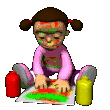

bAcK To tHe KiDqUeSt!
There are so many external and internal stimuli hitting you at once that your brain has learned to filter them out.
The first ones that get ignored are ones that you do; which is why you probably don't notice your vocal chords when you talk, your tongue movements when you chew and why you can't tickle yourself.
When you are tickled, your laughter is the reaction that occurred because that ticklish feeling sends us into a state of panic. You most likely weren't expecting that person to sneak up behind you and tickle your sides, were you? This was probably a defense mechanism that developed in our cave-men ancestors to detect predators.
When you try to tickle yourself you are in complete control of the situation, there is no need to get tense and therefore there is no reaction.
The part of the brain that cancels out stimuli it is expecting is called the cerebellum. The cauliflower-like mass can be found at the back, under the brain.
The cerebellum is known to basically be the party planner, it coordinates movement control in relation to sensory signals received in other areas of your brain.It is possible to tickle yourself though!!!
You would have to fool your cerebellum. Studies have shown that with as little of a 200-millisecond delay between you moving your hand and the tickling, you would react.
However there is only one way to do this- by remote control.
Did you know?
Science has been able to design a robot that allows people to tickle themselves. To use the machine you would have to lie on your back with your eyes closed. The robot, located near you, would have a piece of soft foam attached to a plastic rod which you would control by joystick. You would maneuver the remote control and after a short delay, would respond. This takes advantage of the delay in the cerebellum.